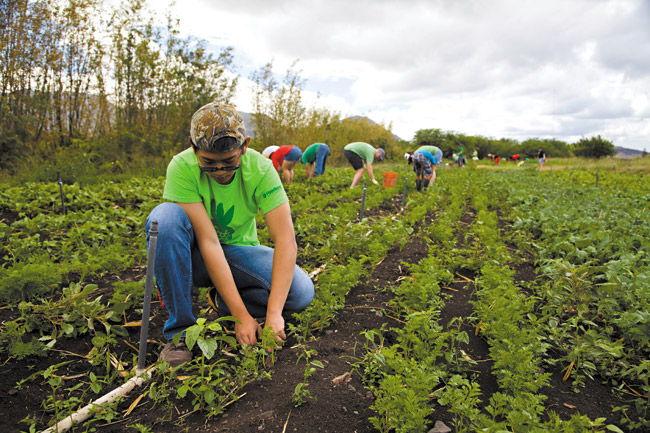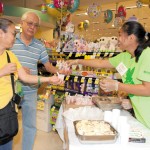Eating Local

Foodland Local Ambassador Renn Salomon from Waipahu High School pulls weeds from among MA‘O Farms’ vegetables PHOTO BY MISSY ROMERO
It’s a Tuesday afternoon at Foodland in Market City Shopping Center.
Inside, Ha Nguyen and Marivic Baoas are setting up and preparing food samples. As they do, both interact with shoppers passing by, answer the occasional question and deal with one particularly difficult customer with poise.
For Hawaii’s largest locally owned supermarket, one would expect no less. But Nguyen and Baoas are no ordinary Foodland representatives. Both happen to be Kaimuki High School students. Together, with about 10 other students from Kaimuki High and more than 200 others throughout the state, they have joined Foodland for Eat Local Tuesdays.
It’s a new initiative the supermarket launched in January with a very simple premise: Help Foodland help Hawaii’s food sustainability.
- Foodland chairwoman and CEO Jenai S. Wall volunteers at MA‘O Farms during a weed-pulling day
- Celia Salvadea and Shari Kikuchi, two Foodland volunteers, happily work together
- Foodland customers Kathy and Ronald Loo from Manoa taste local foods that Local Ambassador and Kaimuki High School student Marivic Baoas serves NATHALIE WALKER PHOTO
“As a local company, we always like to look for whatever we can do to support our community,” says Foodland chairwoman and CEO Jenai S. Wall.
Make the Pledge
Supporting local is something of a no-brainer, according to Wall. On any given day, Foodland shoppers may select from nearly 3,000 unique local items.
But the company recognizes that identifying local products against a sea of outsourced competitors can be a challenge. And as many shoppers know too well, it sometimes means spending considerably more.
In response, and to serve as a bridge between the community and its farmers and producers, Foodland encourages customers to take its Eat Local Tuesdays pledge. In doing so, shoppers commit to eating local one day a week. In return, Foodland has made it easier to spot locally grown or made products at reduced prices daily, and with some added incentives.
On Tuesdays, in particular, shoppers who take the Eat Local Tuesdays pledge receive double Maika‘i points on all local items purchased. They also can select from Tuesday-only deli and poke specials that have, in the past, featured a Hawaiian plate lunch or Foodland’s lomi poke.
Each week, a Local Item of the Week — ground beef, for instance — also is highlighted, and new orange tags flag locally grown or made products.
“We felt that, if we combined the value in the store along with the ease of finding local products, it would be easy for people to make a commitment,” says Wall.
Over time, she is hopeful that Eat Local Tuesdays will encourage customers to buy local more frequently.
‘EAT LOCAL’
In developing Eat Local Tuesdays, Foodland knew that food samples would be key in making its customers aware of available local products. So, it decided to partner with Hawaii’s high schools.
Another no-brainer, when you consider that more than 95 percent of Foodland’s employees are graduates of the state’s public schools.
“We thought that it would be a win-win because we would have them helping us in the store, but they would learn about local products,” says Wall.
To assist with this, Foodland applied for a grant from Hawaii Department of Agriculture (HDOA). Part of a “Buy Local,
It Matters,” campaign that began roughly five years ago, it uses allocated funds through the state’s Agricultural Development and Food Security Special Fund.
Ultimately, awarded programs and activities ideally would decrease Hawaii’s dependence on imported goods and increase local agricultural production. With this in mind, HDOA solicited proposals that also would work to increase Hawaii’s consumption of local food, a project titled “EAT LOCAL.”
“Foodland has long supported local farmers and local products,” says Sharon Hurd with Hawaii Department of Agriculture.
With funds from the grant, Foodland compensates participating schools for the time students spend each Tuesday in its stores. Kapaa High students are involved at the Waipouli store.
Though only a few months in, Foodland has seen the number of customers taking its Eat Local Tuesdays pledge soar to more than 186,000. It’s an outcome Wall credits largely to its student representatives, dubbed Foodland Local Ambassadors.
Foodland Local Ambassadors
Being a Foodland Local Ambassador was nerve-wracking initially for Kapolei High School 10th-grader Jacob Danao. But since joining the program in February, Danao says he’s gotten used to it.
“I’ve been learning more organization and public speaking techniques,” he says.
It’s a sentiment shared by Baoas, also a sophomore, who also was nervous at first but now feels confident in the skills she has honed.
“I learned that I could be way more social,” she says, in between engaging with customers who stop for a sample.
“I like saying ‘hi’ to random people,” she adds. “It just feels good.”
Both serve as perfect examples of what Foodland hopes its Local Ambassadors get out of Eat Local Tuesdays.
“Our goal is to really make it a worthwhile and meaningful experience for them so that they’re not just helping us for three hours,” says Wall. “We really want it to be something that they can learn from.”
Each Tuesday afternoon, students like Danao and Baoas may be found in Foodland, Sack N Save and Foodland Farms stores, serving a selection of four free samples to customers. Currently, 16 schools are participating in Eat Local Tuesdays, with Foodland looking to add on two more.
Wall has observed each school apply and adapt the program differently. Waipahu High School, for instance, required that interested students undergo an application and interview process.
“It was good because it really mirrored what students would experience in the industry when they have to go out and apply for a job,” says Waipahu High principal Keith Hayashi.
Hayashi was the first to sign up his school for Eat Local Tuesdays. It was an easy decision to make, he says, and one he notices already is paying off.
Waipahu High has remained closely involved with Eat Local Tuesdays. Just recently, four teams of students presented ideas to Wall and Foodland that they believe will improve its initiative.
“It was really amazing for us to see,” says Wall, adding that the students now are creating prototypes that the company plans to test run.
“It’s from these opportunities that our students really are able to make connections,” says Hayashi. “It makes learning relevant … so they can understand why they are in school.”
It’s more than just learning applicable life skills, though. Local Ambassadors also are invited to join employees to learn about, and tour and volunteer at farms that sell produce in Foodland. Danao and Baoas both note that, prior to serving as Foodland Local Ambassadors, neither one of them realized the number of supermarket items that were made or grown locally.
In this sense, Local Ambassadors obtain a deeper understanding of buying and eating local — something Wall hopes has a lasting effect on Hawaii’s food economy.
“Our hope is that we’ve taught them about the importance of eating local, and we’ve exposed them to different products that they perhaps didn’t know about before,” says Wall. “And (we want to) help them to understand how buying local and eating local are good for the community in the future.”
For more information on Eat Local Tuesdays and to take the pledge, visit foodland.com. Be on the lookout for Foodland Local Ambassadors in Foodland, Sack N Save and Foodland Farms locations Tuesdays from 3 to 6 p.m. (or 4-7 p.m. at select stores).




